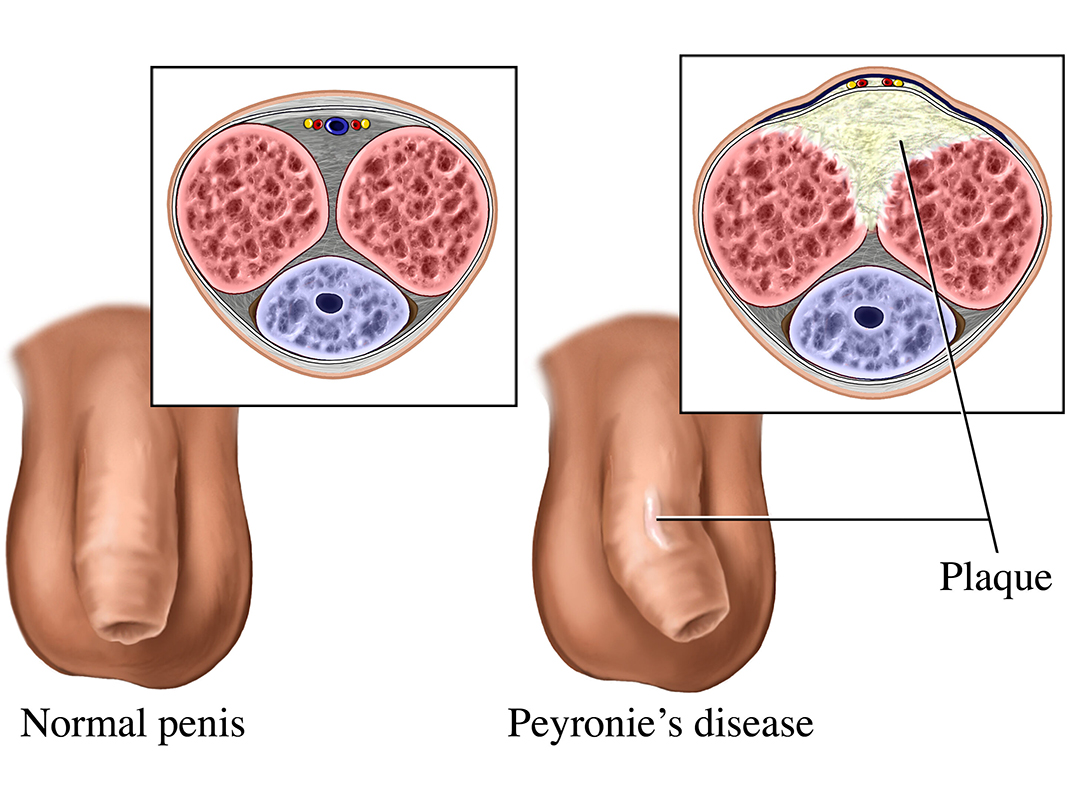Peyronie's Disease Facts
What is Peyronie's disease?

Peyronie’s disease is a disorder in which scar tissue, called a plaque, forms in the penis. The plaque builds up inside the tissues of a thick, elastic membrane called the tunica albuginea. The most common area for the plaque is on the top or bottom of the penis. As the plaque builds up, the penis will curve or bend, which can cause painful erections. Curves in the penis can make sexual intercourse painful, difficult, or impossible. Peyronie’s disease begins with inflammation, or swelling, which can become a hard scar.
The plaque that develops in Peyronie’s disease is not the same plaque that can develop in a person’s arteries. The plaque seen in Peyronie’s disease is benign, or noncancerous, and is not a tumor. Peyronie’s disease is not contagious or caused by any known transmittable disease. Usually, men with Peyronie’s disease are referred to a urologist.
Anatomy
The visible part of the penis is composed of three primary chambers: the urethra and its surrounding supportive tissue and the two paired chambers that become firm during erections. These structures are comprised of a dense elastic covering called the tunica albuginea. The tunica forms a long, balloon-like structure that is filled with a highly vascular spongy tissue.
When an erection occurs, the spongy tissue fills with blood and the elastic tunica is stretched and becomes firm. As the corpora become hard, there are small veins that normally allow the blood to exit the spongy tissue that becomes plugged to trap blood in the penis during an erection.
In the case of Peyronie’s disease, there is scar tissue that develops within the tunica albuginea which may be painful at first. You may be able to feel the scar tissue in the non-erect penis, which feels like a firm lump in the shaft. Finally, the scar tissue will cause the penis to point toward the side of the scar.
In severe cases, it may be difficult for men to keep an erection due to scar tissue opening the tiny veins that are normally closed during an erection.
In extreme cases, the scar tissue will form on both sides of the corpora cavernosa, and the penis will form an indentation or hourglass deformity. When this happens, the penis may have a hinge-like effect during an erection.
What are the causes of Peyronie's disease?
Medical experts do not know the exact cause of Peyronie’s disease. Many believe that Peyronie’s disease may be the result of
- Acute injury to the penis
- Chronic, or repeated, injury to the penis
- Autoimmune disease — a disorder in which the body’s immune system attacks the body’s own cells and organs
Risk factors of Peyronie's disease
The following factors may increase a man’s chance of developing Peyronie’s disease:
- Vigorous sexual or nonsexual activities that cause microscopic injury to the penis
- Certain connective tissue and autoimmune disorders
- A family history of Peyronie’s disease
- Aging (between 40 and 70 years of age)
Signs and symptoms of Peyronie's disease
- Hard lumps on one or more sides of the penis
- Pain during sexual intercourse or during an erection
- A curve in the penis either with or without an erection
- Narrowing or shortening of the penis
- ED - erectile dysfunction
Symptoms of Peyronie’s disease range from mild to severe. Symptoms may develop slowly or appear quickly. In many cases, the pain decreases over time, although the curve in the penis may remain. In milder cases, symptoms may go away without causing a permanent curve.
(Source: National Institute of Diabetes and Digestive and Kidney Diseases)